
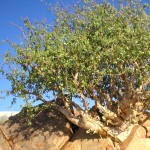
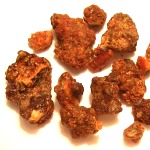

alpha-santalene, alpha-bergamotene,
and (Z)-alpha-bisabolene
Commiphora erythraea var. glabrescens (C. opobalsamum) (Burseraceae) Bisabol Myrrh, Balm of Mecca
This is another of the famous resins of the Orient, see also myrrh and olibanum (frankincense).
All Burseraceans are resinous. The species of the genus Commiphora are thorny bushes and small trees. They are important elements of the African dry-land vegetation. Opopanax is a viscous exudate obtained by breaking the twigs of Commiphora erythraea var. glabrescens, growing in Somalia (Africa's Horn). It solidifies to brown lumps of a warm-balsamic and sweet, honey-like fragrance.
A resinoid is prepared by solvent extraction, and steam distillation of the resin gives an essential oil. They are both used in perfumes of the Oriental type.
The main constituents of opopanax oil are sesquiterpene hydrocarbons like alpha-santalene, alpha-bergamotene, and (Z)-alpha-bisabolene [146].
According to Arctander, the olfactory difference between myrrh oil and opopanax oil is the vegetable-soup-like, slightly animalic-sweet odor of opopanax oil compared with the medicinal-sharp freshness of myrrh oil.
Etymology: The term "opopanax", meaning "all healing juice", is a source of confusion, since it is also used for the gum latex from several umbellifers, e.g. from Opopanax chironium (Pastinaca opopanax) (Umbelliferae), indigenous to the Mediterranean area [147].
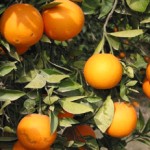
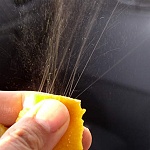

(all-E)-alpha-sinensal
2,6,10-trimethyl-2(E),6(E),9(E),11-dodecatetraenal
-limonene.gif)
(+)-limonene
Citrus sinensis (Rutaceae) Sweet orange
The familiar citrus fruits - orange, lemon, grapefruit, mandarin, lime fruit, bergamot, bitter orange, etc. - each have their own characteristic aroma. If an orange is peeled in a railway coupe, it is immediately identified. The peel's oil glands burst with an aerosol of tiny evaporating droplets, filling the air with the characteristic smell of orange. As with most citrus oils, (+)-limonene is the major component, but the distinctive fresh sweetness from the orange peel is mainly due to the sesquiterpene aldehyde sinensal, especially the isomer (all-E)-alpha-sinensal, whose odour detection threshold is as low as 0.05 ppb [3].
Orange oil, obtained by cold-pressing of the peels, is made in several countries in conjunction with orange juice production. It is used in perfumes of the Cologne type, and as an aroma in soft drinks.
Etymology: The members of the genus Citrus belongs to the Rutacean family, named after rue, one of its smaller members.
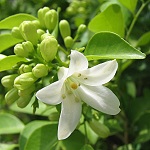
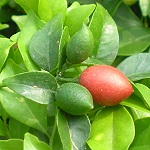
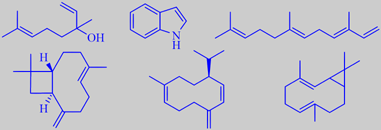
linalool, indol, farnesene, caryophyllene, germacrene d, bicyclogermacrene
Murraya paniculata (Rutaceae)
Murraya is related to Citrus, and the flowers of Murraya paniculata, commonly known as Orange Jessamine, are strongly scented in the direction of citrus flowers although somewhat lighter and greener. Orange Jessamine is a native of South and Southeast Asia, China and Australasia. It is a small tropical tree or shrub with un-edible fruits resembling kumquats but turning red when ripe. It is a popular ornamental. Honey collected from bee hive colonies foraging on the flowers has a tangy sweet orange undertone.
Rout et al. investigated the volatiles of Orange Jessamine flowers by various methods and found that the headspace of the live flowers is dominated by linalool, indole, (E,E)-alpha-farnesene, (E)-caryophyllene, germacrene d and bicyclogermacrene, whereas the absolute (obtained by pentane extraction followed by methanol extraction) has manool as the major component together with phenethyl alcohol, indole, nerolidol, benzyl benzoate and phenethyl benzoate [308] [309].
Etymology: Lat. paniculata, i.e. the flowers come in panicles.
p.s. The Curry Leaf Tree of India, Murraya koenigii, is a close relative. The leaves of this tree, also called sweet neem leaves, are used in many dishes and curries in India and neighbouring countries.
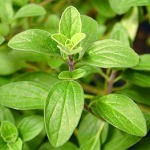
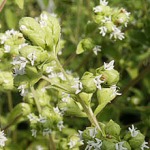

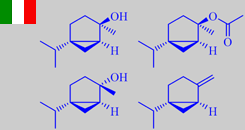
major odorants in sweet marjoram
Oregano
Origanum majorana (Labiatae) Sweet marjoram
There are about twelve species of Origanum, all natives of the
Mediterranean area and the Near East. A lot of cultivars and many hybrids
exist. The influence of climate, season and soil on the composition of
the essential oil is often greater than the difference between the various
species.
The oregano usually preferred as a spice is O. majorana or sweet
marjoram. It has a natural distribution from Egypt and Arabia to India
but is now grown in most of the world. The tops are harvested before flowering,
then dried and comminuted.
The main essential oil components of sweet marjoram are the bicyclic sabinyl
monoterpenes shown: cis-sabinene hydrate, cis-sabinene hydrate acetate,
trans-sabinene hydrate and sabinene. Hydrodistillation of the essential
oil commonly results in artifact formation with high contents of especially
terpinen-4-ol and gamma-terpinene.
The flavour of the related species O. vulgare or wild marjoram
is generally strongly phenolic due to the presence of thymol and carvacrol
[76] [77].
Oregano is a sine qua non of the Italian cuisine. Maybe the dish most
associated with oregano is pizza.
Etymology: Gr. oros, mountain; Gr. ganos, delight.
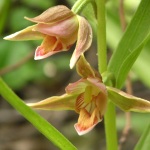
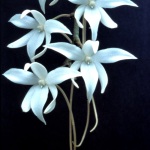
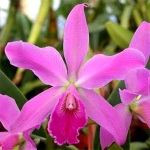
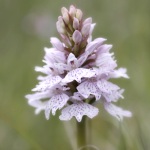
(Orchidaceae)
With more than twenty thousand species, the orchids are by far the largest group among the monocots.
In everyday speech, orchids are considered to be expensive plants with large, richly coloured flowers, but many species have flowers of only a few millimetres' size. A large number of orchids show highly specific adaptation to (or co-adaptation with) their pollinators. Some are luring male insects by having flowers mimicing the females in both appearance and pheromone odour.
In accordance with their adaptation to specific pollinators, orchids may be scented only at specific times during the day or night. And their odours show a diversification as impressive as their looks - 'overripe cherry-plum-like', 'patchouli-tagetes-like', 'fresh lemony', 'animal-fatty' are a few impressions from the orchid house in The Botanic Garden in Copenhagen. Many perfumes have borrowed from the exotic connotations of the orchid, but to describe a fragrance as being 'orchid-like' is completely meaningless without a reference to a specific orchid.
Etymology: Gr. orchis, testicles, referring to the shape of the root nodules of the genus Orchis.
Only two species will be briefly mentioned here (see vanilla too!):
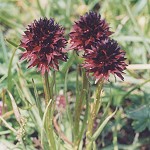
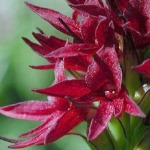
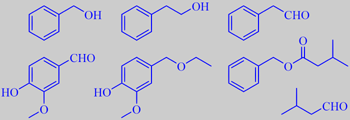
major odorants from Nigritella nigra
Nigritella nigra (Orchidaceae)
This orchid, an endangered species in Scandinavia, is common in the Alps.
Its habitat is sunny, dry alpine meadows on calcareous ground at attitudes
of 1000 to 2800 m. It is locally known as Männertreu or Orchis vanillé.
The dark purple flowers are strongly fragrant with a sweet, cocoa-vanilla-shaded
odour.
The scent is based on phenethyl alcohol and benzyl alcohol and additionally
contains a number of compounds also identified in vanilla
and cocoa extracts
- vanillin, vanillyl ethyl ether, phenylacetaldehyde, isovaleraldehyde,
benzyl isovalerate, etc. [33].
Etymology: Lat. niger, black, as the flowers at a distance have
an almost black appearance.
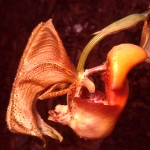
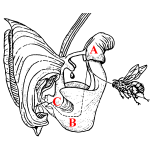
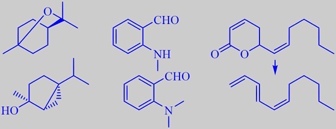
major odorants from Coryanthes kaiseriana
Coryanthes kaiseriana G. Gerlach (Orchidaceae)
Coryanthes kaiseriana, a recently discovered orchid from Costa
Rica and Panama, has been named after Givaudan scientist Dr. Roman Kaiser
for his research in orchid scents. It belongs to a group of so-called
perfume orchids or euglossine orchids, whose pollinators (euglossine bees)
use the orchids' scents in their own reproductive biology. The flowers
are without nectar. The bees collect the scent at A,
fall into the fluid-filled bucket B, and
are forced to leave the orchid at C whereby
it is pollinated.
The scent of C. kaiseriana is dominated by the rare natural compound
N-methyl anthranilaldehyde, or
2-(methylamino)benzaldehyde, which is characterized by a peculiar dusty,
leathery but still sweetish odor, according to Roman Kaiser. The N-dimethyl
analogue is also present. Moreover, traces of the intensely scented (3E,5Z)-undeca-1,3,5-triene
(also known from galbanum)
make a contribution, together with its precursor, (6Z)-dodeca-2,6-dieno-5-lactone.
1,8-cineole and trans-sabinene hydrate are major terpenoids [167].
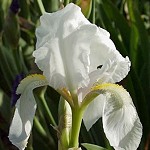
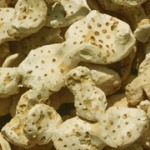

(-)-cis-gamma-irone

(-)-cis-alpha-irone
Iris pallida (I. florentina) (Iridaceae) Sweet iris
Orris root is the dried rhizome of the sweet iris, I. pallida. Since old ages it has been a remedy in folk medicine, and even today it is sometimes used to chew on for babies getting teeth. The major cultivation area is near Florence in the Italian province of Tuscany, but for another chief purpose. The roots upon ageing get a fine violet-like odour and are the source of the famous and very expensive orris root oil, having an outstanding effect in perfumes. The ageing takes several years, as the active ingredients arise from slow oxidation of triterpenoid compounds resembling ambrein. The most important odorants from orris root are the methylionones (-)-cis-gamma-irone and (-)-cis-alpha-irone. A high content of myristic acid makes the distillate a waxy mass. The yield is as low as 0.2 % [3] [6].
Etymology: Gr. iris, rainbow, because of the often richly coloured flowers of this genus.